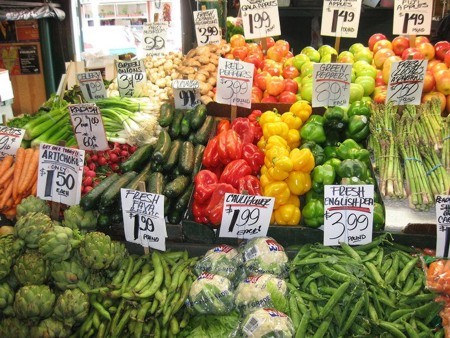According to a recent survey, Canadians throw out more than $2.5 billion a year worth of spoiled or spoiling, or just unappealing-looking produce. And the cause of this unbelievable waste of otherwise good food seems to be improper storage, proceeding from a lack of knowledge about how to handle common foods properly.
We’ve already commented on the right way to load your fridge (i.e.- what shelf to use for what foods). But there’s more to staving off spoilage than that!
The first, most important rule…
If it’s on an open, uncovered, unrefrigerated display in the supermarket, leave it that way at home for best, longest keeping. If it’s on a refrigerated, misted ‘cooler’ display, put it in the crisper at home. If it’s not wrapped or bagged, don’t store it wrapped or bagged.
Store cut vegetables (a leftover half onion, for example) tightly wrapped in plastic film and use within 48 hours.
Bananas and onions should be stored in well ventilated spot on the kitchen counter. They produce gasses that hasten ripening (and, thereafter, rotting) if confined in the fridge, a cabinet, a bag or a wrapper.
Potatoes should never be refrigerated. They’ll turn black. Store them in cool, dry conditions, away from sunlight. Heat and sunlight will make them sprout. I put mine on a lower shelf on one of my kitchen workstations in a well-ventilated basket and cover them with a towel to keep them in the dark.
I have a herb garden in the summer. I always have far more ‘produce’ from that source than I can use day by day. So, I harvest some every few days, keeping them in a high shelf of the fridge in heavy (freezer-weight) zip-closure bags with as much of the air as possible squeezed out. They’ll last 4-5 days in ideal conditions.
About the crisper…
Most crispers are located in the bottom of the fridge, where the coldest air collects. This isn’t necessarily the best spot for veggies, especially if you keep your fridge really cold. More on that in a bit. But you can help prolong the palatable life of your crisper veggies by observing a number of simple rules.
Use the humidity control on your crisper to best advantage. Some veggies want moisture – leafy ones, for example – while others, like carrots, want it drier. Put your leafy greens plus anything from the cabbage family (Broccoli, Cauliflower, Brussel’s Sprouts, etc.) in a moist drawer.
Store Mushrooms, Grapes, Fresh Berries and other delicate items in the low-humidity drawer.
Everything else can go on the counter, or in a well-ventilated basket on the dining room table as a centrepiece. And buy things like Bananas, Tomatoes, Melons, Avocados and Pears a little under-ripe. They’re ripen up gradually, over a few days, on their own. I like to get some ripe tomatoes for immediate use, some almost ripe for use a couple of days down the road, and some still a bit greenish around the stem end for use by the end of the week.
About the fridge, itself…
You should keep your fridge at temperature that ensures that all areas of the fridge are no warmer than 4 C (40 F). That’s not easy, since many residential fridges use very cold air spilling out of the freezer compartment on top to cool the fridge section. The temperature of the fridge is controlled by controlling the downward flow of freezer air. If you have your freezer turned up full, your fridge will be too cold, especially in the bottom, where the coldest air will collect. Have you ever had frozen veggies in the bottom of your crisper? That’s why. So… It’s important to keep your fridge set at just the right temperature so that your freezer stuff stays solid and your fridge stuff never freezes!
Try my tips for happier produce and save a bundle on your grocery bill!
~ Maggie J.

